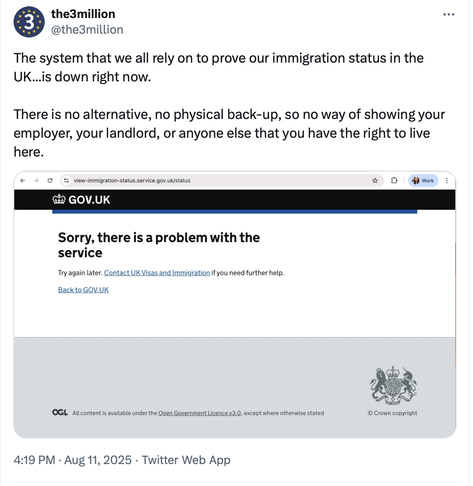2025-10-09 08:13:42
Ok, yeah, I'm not done processing my anger over liberals doing shit like this. So this historian sees a rise in right wing violence, sees the US government carrying out ethnic cleansing, sees a rise in white supremacist terrorism, and then says, "oh yeah... this reminds me of a time right around the 1920s. Hum... yeah, ANARCHISTS fighting the government! Yeah, that's the same thing."
FFS, IT'S THE RED SUMMER! If you want a parallel between today and some horrible time in US history, TALK ABOUT THE RED SUMMER. The point of the language of dehumanization that the right uses, the point of all the anti-black and anti-emigrant rhetoric, is that it leads to genocide. Trump already carried out an act of genocide (#USPol
2025-10-11 00:21:02
Read every embarrassing thing about felon trump into the congressional record.
Make it a weekly night event on the floor for cspan and advertise it.
Make a bingo game out of it.
Read off the court transcripts trump and his ilk.
Enjoy yourselves while you do this.
Bullies hate being mocked.
If the GNP (Grand Nazi Party) wants to stop you, make them own the chamber 24/7.
Tell them you will stop making them own the space when they start to push bac…
2025-08-11 15:35:06
2025-08-10 14:51:01
Top AI Experts Concerned That OpenAI Has Betrayed Humankind
https://futurism.com/openai-open-letter-experts-humankind?utm_source=flipboard&utm_content=topic/technology
2025-10-10 12:06:25
Join me at two events at the British Library later this month:
https://www.bl.uk/stories/blogs/posts/knowledge-is-human
On 20 October, the British Library is joining forces with Wikimedia UK and the Wikimedia Foundation to explore the impact of AI on ope…
2025-10-11 07:30:29
2025-10-09 09:20:30
Open letter to Irish minister who's pushing ChatControl from @…
https://crookedtimber.org/20…
2025-08-10 18:03:30
Zweiter Prototyp einer Kartenmischmaschine aus Lego. Da der Legomotor innerlich zerfällt (nach zwanzig Jahren), habe ich einen von Sonos genommen.
Die Karten werden in zwei gleich große Stapel aufgeteilt und in das jeweilige Fach gelegt. Der Motor treibt zwei Gummiräder unter den Stapeln an, sodass jeweils ein bis zwei Karten herausgezogen und in den Auffangbehälter in der Mitte geworfen werden.
Grundsätzlich funktioniert ist. Probleme gibt es wenn der Stapel zu hoch ist, dann is…
2025-10-02 19:43:19
"""
[…] Paradoxically, the more a population grew, the more precious it became, as it offered a supply of cheap labour, and by lowering costs allowed a greater expansion of production and trade. In this infinitely open labour market, the ‘fundamental price’, which for Turgot meant a subsistence level for workers, and the price determined by supply and demand ended up as the same thing. A country was all the more commercially competitive for having at its disposal the virtual wealth that a large population represented.
Confinement was therefore a clumsy error, and an economic one at that: there was no sense in trying to suppress poverty by taking it out of the economic circuit and providing for a poor population by charitable means. To do that was merely to hide poverty, and suppress an important section of the population, which was always a given wealth. Rather than helping the poor escape their provisionally indigent situation, charity condemned them to it, and dangerously so, by putting a brake on the labour market in a period of crisis. What was required was to palliate the high cost of products with cheaper labour, and to make up for their scarcity by a new industrial and agricultural effort. The only reasonable remedy was to reinsert the population in the circuit of production, being sure to place labour in areas where manpower was most scarce. The use of paupers, vagabonds, exiles and émigrés of any description was one of the secrets of wealth in the competition between nations. […]
Confinement was to be criticised because of the effects it had on the labour market, but also because like all other traditional forms of charity, it constituted a dangerous form of finance. As had been the case in the Middle Ages, the classical era had constantly attempted to look after the needs of the poor by a system of foundations. This implied that a section of the land capital and revenues were out of circulation. In a definitive manner too, as the concern was to avoid the commercialisation of assistance to the poor, so judicial measures had been taken to ensure that this wealth never went back into circulation. But as time passed, their usefulness diminished: the economic situation changed, and so did the nature of poverty.
«Society does not always have the same needs. The nature and distribution of property, the divisions between the different orders of the people, opinions, customs, the occupations of the majority of the population, the climate itself, diseases and all the other accidents of human life are in constant change. New needs come into being, and old ones disappear.» [Turgot, Encyclopédie]
The definitive character of a foundation was in contradiction with the variable and changing nature of the accidental needs to which it was designed to respond. The wealth that it immobilised was never put back into circulation, but more wealth was to be created as new needs appeared. The result was that the proportion of funds and revenues removed from circulation constantly increased, while that of production fell in consequence. The only possible result was increased poverty, and a need for more foundations. The process could continue indefinitely, and the fear was that one day ‘the ever increasing number of foundations might absorb all private funds and all private property’. When closely examined, classical forms of assistance were a cause of poverty, bringing a progressive immobilisation that was like the slow death of productive wealth:
«If all the men who have ever lived had been given a tomb, sooner or later some of those sterile monuments would have been dug up in order to find land to cultivate, and it would have become necessary to stir the ashes of the dead in order to feed the living.» [Turgot, Lettre Š Trudaine sur le Limousin]
"""
(Michel Foucault, History of Madness)
2025-10-08 12:05:57
Open letter: 40 European companies oppose the EU's "Chat Control" proposal, which forces services to scan messages for CSAM, fearing it would mandate backdoors (CryptPad Blog)
https://blog.cryptpad.org/2025/10/07/open-letter-against-chat-control/




